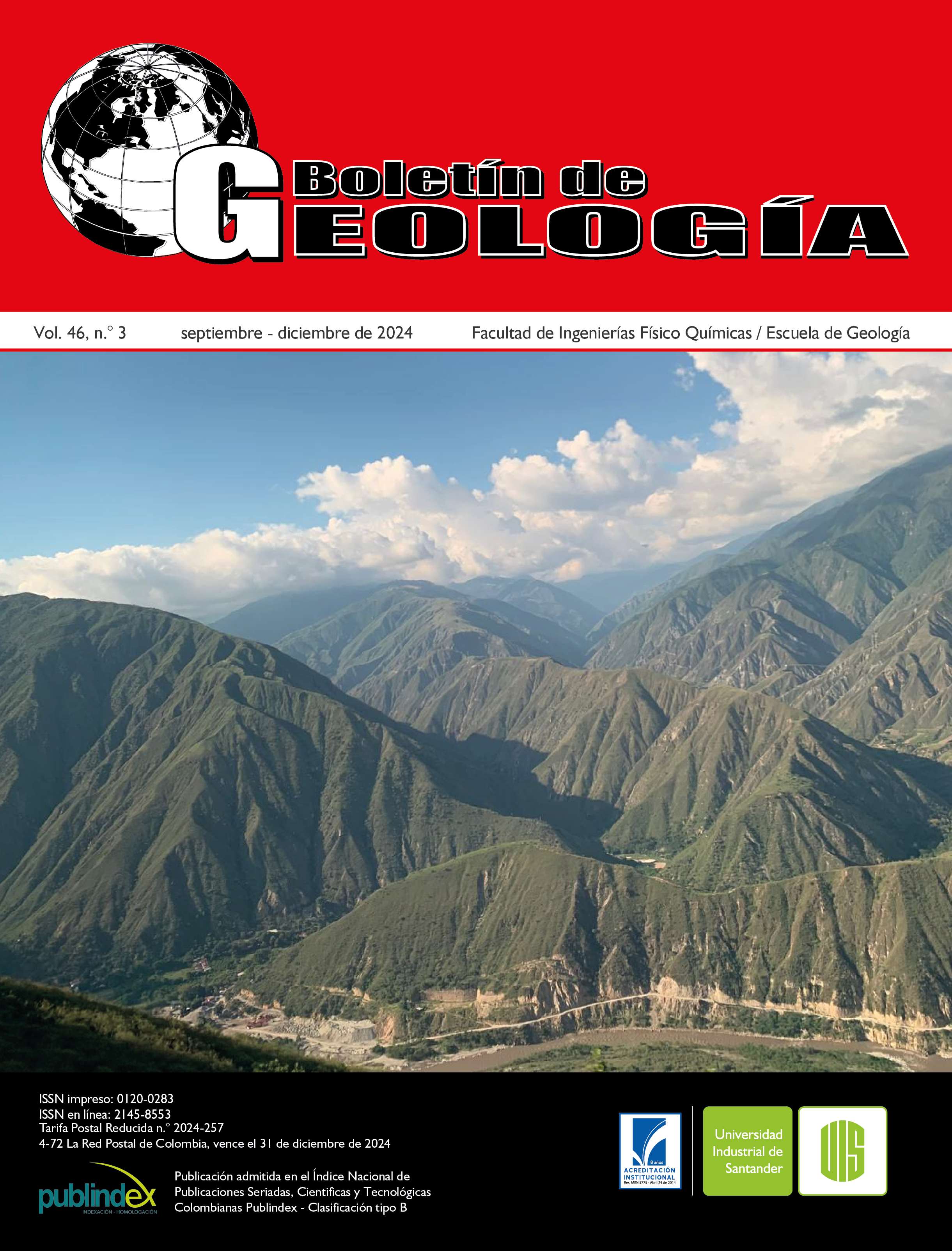Publicado 2024-11-28
Palabras clave
- Pliegue por propagación de falla,
- Trishear,
- Kink,
- Análisis estructural
Cómo citar
Derechos de autor 2024 Boletín de Geología

Esta obra está bajo una licencia internacional Creative Commons Atribución 4.0.
Altmetrics
Resumen
El anticlinal de Puquín es una estructura geológica ubicada en la región de Cusco que se extiende ~9,8 km. En el núcleo del anticlinal afloran rocas sedimentarias de la Formación Puquín (Cretácico Tardío); en los flancos afloran rocas sedimentarias de las formaciones Quilque (Paleoceno Temprano), Chilca (Paleoceno Tardío), Kayra (Eoceno) y Soncco (Eoceno-Oligoceno). Tiene un rumbo de eje de pliegue N-S, se caracteriza como un pliegue asimétrico, cerrado en su porción norte y centro y abierto en su porción sur, y con eje con doble inmersión de ~21°S y ~34°N. El flanco frontal presenta mayor engrosamiento que el flanco trasero y es atravesado por un retrocorrimiento. Por sus características el anticlinal de Puquín es interpretado como un pliegue por propagación de falla transportado. El acortamiento calculado a partir de tres secciones estructurales, realizadas por el método de trishear, es de 8,32 km (15,1%), 8,61 km (12,1%) y 8,62 km (12,0%) para las zonas norte, centro y sur, respectivamente. El análisis del patrón de fracturas, fallas y vetillas realizado en 23 estaciones estructurales en distintos sectores del anticlinal permitió distinguir 5 juegos de orientaciones: ONOESE, NNE-SSO, O-E, NE-SO y OSO-ENE. Estas estructuras son compatibles con el arreglo estructural que se origina en los pliegues, específicamente en este caso con el pliegue de Puquín.
Descargas
Referencias
- Allmendinger, R.W. (1998). Inverse and fordward modeling of trishear fault-propagation folds. Tectonics, 17(4), 640-656. https://doi.org/10.1029/98TC01907
- Allmendinger, R.W. (2012). FaultFoldForward.v.6. http://www.geo.cornell.edu/geology/faculty/RWA/programs/faultfoldforward-v-6.html
- Allmendinger, R.; Cardozo, N.; Fisher, D. (2012). Structural geology algorithms: Vectors. Cambridge University Press. https://doi.org/10.1017/CBO9780511920202
- Buxtorf, A. (1916). Prognosen und Befunde beim Hauensteinbasis-und Grenchenburg-tunnel und die Bedeutung der letzteren für die Geologie des Juragebirges. Naturforschung Gesellschaft Basel Verhandlungen, 27, 184-254.
- Cabrera, J. (1988). Néotectonique et sismotectonique dans la Cordillère Andine au niveau du changement de géometrie de la subduction: la région de Cusco, Pérou. Thése Docteur, Université Paris-Sud, Francia.
- Cadell, H.M. (1889). Experimental researches in mountain building. Earth and Environmental Science Transactions of the Royal Society of Edinburgh, 35(1), 337-357. https://doi.org/10.1017/S0080456800017658
- Callot, P. (2008). La Formation Ayabacas (limite TuronienConiacien, Sud-Pérou): collapse sous-marin en réponse à l’amorce de l’orogenèse andine. Thèse Docteur, Université Paul Sabatier, Toulouse, Francia.
- Carlotto, V.; Gil, W.; Cárdenas, J.; Chávez, R. (1996). Geología de los cuadrángulos de Urubamba y Calca. INGEMMET, Boletín, Serie A: Carta Geológica Nacional, 65.
- Carlotto, V. (1998). Évolution andine et raccourcissement au niveau de Cusco (13-16°S), Pérou: enregistrement sédimentaire, chronologie, contrôles paléogéographiques, évolution cinématique. Thèse Docteur, Université de Grenoble I, Francia.
- Carlotto, V.; Jaillard, E.; Carlier, G.; Cárdenas, J.; Cerpa, L.; Flores, T.; Latorre, O.; Ibarra, I. (2005). Las cuencas terciarias sinorogénicas en el Altiplano y en la Cordillera Occidental del sur del Perú. En: J. Arce (ed.). Alberto Giesecke Matto (pp. 103-126). Sociedad Geológica del Perú.
- Carlotto, V. (2006). La deformación y el acortamiento andino en el sur del Perú: Cusco-Abancay-Sicuani. Boletín Sociedad Geológica del Perú, 101, 91-119.
- Carlotto, V.; Cardénas, J.; Carlier, G. (2011). Geología del cuadrángulo de Cusco, hoja 28-s, escala 1:50,000. INGEMMET. Boletín, Serie A:138 Carta Geológica Nacional.
- Carlotto, V. (2013). Paleogeographic and tectonic controls on the evolution of Cenozoic basins in the Altiplano and Western Cordillera of southern Peru. Tectonophysics, 589, 195-219. https://doi.org/10.1016/j.tecto.2013.01.002
- Dahlstrom, C.D.A. (1970). Structural geology in the eastern margin of the Canadian Rocky Mountains. Bulletin of Canadian Petroleum Geology, 18(3), 332-406. https://doi.org/10.35767/gscpgbull.18.3.332
- Fleuty, M.J. (1964). The description of folds. Proceedings of the Geologists’ Association, 75(4), 461-492. https://doi.org/10.1016/S0016-7878(64)80023-7
- Hardy, S.; Ford, M. (1997). Numerical modeling of trishear fault propagation folding. Tectonics, 16(5), 841-854. https://doi.org/10.1029/97TC01171
- Heim, A. (1878). Untersuchungen über den Mechanismus der Gebirgsbildung im Anschluss an die geologische Monographie der Tödi-Windgällen-Gruppe: Atlas, Volumen 3. Benno Schwabe.
- Jaillard, E.; Sempere, T. (1989). Cretaceous sequence stratigraphy of Peru and Bolivia. In: Contribuciones de los simposios sobre el Cretácico de América Latina, Parte A: Eventos y registro sedimentario. Buenos Aires, 1-27.
- Jaillard, E. (1993). L’évolution tectheionique de la marge péruvienne au Sénonien et Paléocène et ses relations avec la géodynamique. Bulletin Socété Géologique de France, 164(6), 819-830.
- Jaillard, E. (1994). Kimmeridgian to Paleocene tectonic and geodynamic evolution of the Peruvian (and Ecuadorian) margin. En: J.A. Salfity (ed.). Cretaceous tectonics of the Andes (pp. 101-166). Vieweg Publishing. https://doi.org/10.1007/978-3-322-85472-8_3
- Jamison, W.R. (1987). Geometric analysis of fold development in overthrust terranes. Journal Structural Geolology, 9(2), 207-219. https://doi.org/10.1016/0191-8141(87)90026-5
- Mitra, S. (1990). Fault-propagation folds: geometry, kinematic evolution, and hydrocarbon traps. AAPG Bulletin, 74(6), 921-945. https://doi.org/10.1306/0C9B23CB-1710-11D7-8645000102C1865D
- Mitra, S. (2002). Fold-accommodation faults. AAPG Bulletin, 86(4), 671-693. https://doi.org/10.1306/61EEDB7A-173E-11D7-8645000102C1865D
- Newell, N.D. (1949). Geology of the Lake Titicaca region, Perú and Bolivia. Geological Society of America.
- Peach, B.N.; Horne, J.; Gunn, W.; Clough, C.T.; Hinxman, L.W.; Cadell, H.M. (1888). Report on the recent work of the Geological Survey in the north-west Highlands of Scotland, based on the field notes and maps. Quarterly Journal of the Geological Society, 44, 378-441. https://doi.org/10.1144/GSL.JGS.1888.044.01-04.34
- Poblet, J. (2004). Geometría y cinemática de pliegues relacionados con cabalgamientos. Trabajos de Geología, 24, 127-146. https://doi.org/10.17811/tdg.24.2004.127-147
- Rich, J.L. (1934). Mechanics of low-angle overthrust faulting as illustrated by Cumberland thrust block, Virginia, Kentucky and Tennessee. AAPG Bulletin, 18(12), 1584-1596. https://doi.org/10.1306/3D932C94-16B1-11D7-8645000102C1865D
- Sibson, R.H. (1996). Structural permeability of fluid-driven fault-fracture meshes. Journal of Structural Geology, 18(8), 1031-1042. https://doi.org/10.1016/0191-8141(96)00032-6
- Sitter, L. (1976). Geología Estructural. Editorial Omega S.A., 4ta edición.
- Suppe, J. (1983). Geometry and kinematics of fault-bend folding. American Journal of Science, 283(7), 684-721. https://doi.org/10.2475/ajs.283.7.684
- Suppe, J. (1985). Principles of structural geology. Prentice Hall.
- Suppe, J.; Medwedeff, D. (1990). Geometry and kinematics of fault-propagation folding. Eclogae Geologicae Helvetiae, 83(3), 409-454.
- Twiss, R.; Moores, E. (2007). Structural Geology. 2nd edition. W.H. Freedman and Company.

